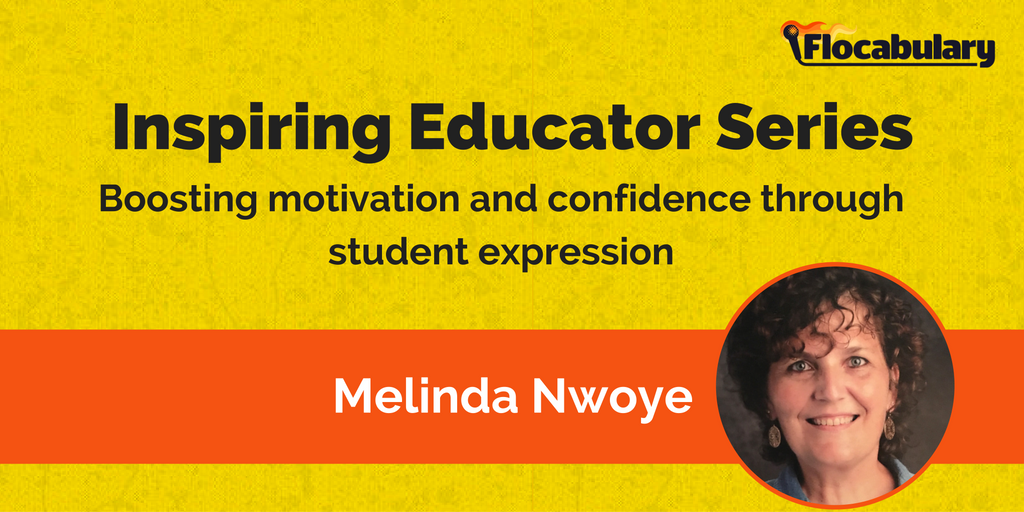
Inspiring Educator Series: Boosting Motivation and Confidence Through Student Expression with Melinda Nwoye
Last month, a Flocabulary team member stumbled upon a Facebook video from Melinda Nwoye: “The Lie.” It stopped us in our tracks—watch it here yourself to learn why.
The Lie from Untitled Productions on Vimeo.
We were struck by the maturity displayed by the students and by the importance of their message. Because we’re passionate about student voice (and believe is a critical component in engaged and motivated classrooms), we spoke with the teacher that made this project a reality: Melinda Nwoye. Read on to learn how she creates a positive classroom culture, her biggest inspiration as an educator and much more.

Leading up to the presidential election, there were negative comments being said about certain populations of people in our country. My diverse classroom had students that were representatives of those populations being targeted. One morning, as students entered the classroom, their conversations were about some of the negative things that were being said about Latinos. So I felt it was necessary that we as a class talk about how prejudice and bias can hurt others.
I was overwhelmed by the number of students in my class that, at some point in their lives, experienced someone stereotyping them based on their race, ethnicity, religion or gender. They were disturbed as they heard each other’s stories as to why someone would treat them like that or say those things.
I shared stanzas of Maya Angelou’s poem, “Still I Rise” and Langston Hughes’ poem, “I, Too.” We talked about how the poets were able to share their thoughts and feelings while fighting against prejudice. We talked about how they felt the poet saw him/herself triumph in the end. It was decided then, that a poetry project would be a great avenue for my students to express themselves while passing on a message to others.
When students are given more opportunities to express themselves, it builds their confidence and gives them a greater sense of self. Also, they feel more invested in their learning and that their contributions are valued.
Giving students the opportunity to express themselves allows them to see that even if we have different opinions on issues, we still need to show each other respect. It is through these experiences that we develop empathy, compassion, and understanding of others—not only in our classroom, but around the world.
First, start with creating a classroom culture of acceptance and respect. For students to feel comfortable expressing themselves, they need to understand that the classroom is a safe place and that their opinions are valued as much as other students’ in the classroom.
Once the classroom culture has been established, I recommend providing students with more choices in how they will learn the objectives. The more that they feel a part of what they are learning, the more they will feel invested in what they are doing.
Since I teach through project based learning, every quarter I create a list of the major topics that are to be covered within the quarter. I then ask students to vote on what they want to focus on for our project. After generating a list of questions that they have about the topic, students are then given the choice to select what area they want to research. Students are aware that they will need to share what we have learned with others and are given the choice of how they will present their information that they learned.
I am more of a facilitator than the main speaker in my classroom. It is through listening to students that I am able to determine the appropriate amount of support that is necessary for them to be successful.
Humor is a great way to bring joy into the classroom. We laugh every day. I have three teenagers and I’m aware of the slang language that is current among the youth in our community. So, of course, our Halloween party was “lit.” (My students think that it is very funny that I use those words in class.) I also know that if I come into the classroom in the morning excited and ready to teach, students are more energized.
Since starting to use Flocabulary videos, I’ve found that even if students are having a rough time getting going in the morning, once the video starts they are ready to go. They are up on their feet dancing and singing with the videos. The videos help start our days and keep the energy flowing throughout.
[Tweet “”Humor is a great way to bring joy into the classroom. We laugh every day.” -@mdnwoye “]
Every year, my class is full of different personalities and learning abilities. This year, I have more extremes than in previous years. Getting to meet their needs while giving them the opportunity to work collaboratively with others has been a challenge, as productivity levels differ. Being more flexible in my instructional methods, having more patience to find what works for each child, and being more supportive by allowing them to discover what strategies work best for them (without me just telling them this is how it is done) has been a struggle.
As I reflected on their needs and how best to meet them, I have decided to implement independent project time each week. This gives me one-on-one instructional time while still providing them the time to work collaboratively on our class project.
The students inspire me to push myself as an educator. I am delighted to see them grow through the course of the year as confident, enthusiastic and motivated learners. They become engaged, active participants in their own learning and are equipped with the strategies that will further their success. Every student in my classroom can see themselves as an integral part of our community, that they are valued, and they are cared for. Their successes, no matter how big or small, are my success—and we celebrate together.
